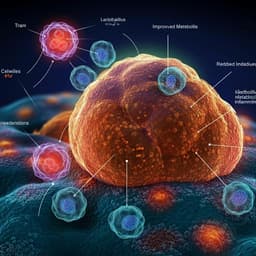
Medicine and Health
Simultaneously targeting SOAT1 and CPT1A ameliorates hepatocellular carcinoma by disrupting lipid homeostasis
M. Ren, H. Xu, et al.
Explore groundbreaking findings from Meiling Ren, Huanji Xu, Hongwei Xia, Qiulin Tang, and Feng Bi on the impact of lipid homeostasis in hepatocellular carcinoma. Their study reveals a complex interplay between SOAT1 and CPT1A that could lead to novel combination therapies, offering hope in the fight against HCC.
~3 min • Beginner • English
Introduction
Cancer cells reprogram metabolism to adapt to their microenvironment. Beyond the Warburg effect, altered fatty acid metabolism is a hallmark of many tumors. In hepatocellular carcinoma (HCC), especially steatohepatitis-associated HCC, excessive free fatty acids (FFAs) from obesity and adipose lipolysis create a lipid-rich milieu that can be cytotoxic (lipotoxicity) if not properly regulated. Lipid homeostasis balances FFA input (biosynthesis and uptake) and export (storage as lipid droplets, oxidation, conversion, excretion). When FFAs are in excess, SOAT1/2 esterify them to cholesterol esters for lipid droplet formation, while non-esterified FFAs are oxidized via mitochondrial fatty acid β-oxidation (FAO), with CPT1 as the rate-limiting gatekeeper for mitochondrial import. Prior reports indicate SOAT1 and CPT1 are overexpressed in several cancers and that blocking a single fatty acid degradation pathway can suppress tumor growth. However, how HCC coordinates fatty acid storage and oxidation to prevent lipotoxicity, and whether jointly targeting these pathways offers therapeutic benefit, remains unclear. This study investigates the interplay between SOAT1-mediated storage and CPT1A-mediated FAO, positing a double-negative feedback that maintains lipid homeostasis in HCC and exploring dual inhibition as a therapeutic strategy.
Literature Review
The authors summarize prior knowledge that cancer cells exhibit metabolic reprogramming, including reliance on aerobic glycolysis and altered fatty acid metabolism. Excess FFAs can induce lipotoxicity, necessitating tight homeostatic control. SOAT enzymes (SOAT1/2) catalyze cholesterol esterification for lipid droplet formation, while CPT1 controls mitochondrial FAO, generating acetyl-CoA for the TCA cycle or ketogenesis. Both SOAT1 and CPT1 are reported overexpressed in multiple cancers (breast, HCC, GBM), and inhibiting fatty acid esterification or oxidation alone can suppress tumor growth. There is limited research addressing these two fatty acid degradation routes together in HCC. The literature also suggests FAO and ketone body production can support tumor survival under nutrient limitation. These gaps motivate examining coordinated regulation of SOAT1 and CPT1A in HCC and testing combined targeting.
Methodology
- In vivo HCC models: Diethylnitrosamine (DEN, 80 mg/kg, i.p., weekly for 5 weeks) was used to induce HCC in male C57BL/6J mice. Mice were fed normal diet (ND) or 60% high-fat diet (HFD). After 12 weeks of HFD, obese mice received avasimibe (AVA, 35 mg/kg, oral gavage, three times/week). Mice were housed for 12 months before analysis. Liver tumors were collected and total tumor volume measured by displacement (final volume minus PBS volume). Survival was assessed by Kaplan–Meier analysis. Histology and IHC were performed on paraffin-embedded sections (H&E; IHC for SOAT1, CPT1A, Cyclin D1, TIP47, HMGCL).
- Xenograft model: Male BALB/c nude mice were injected subcutaneously with HepG2 cells (5×10^6). After tumors reached ~180 mm^3, mice were randomized (n=8/group) to vehicle, avasimibe (15 mg/kg/day, i.p.), etomoxir (ETO, 10 mg/kg/day, i.p.), or combination for up to 28 days. Tumor size was calipered every 3 days; volume V = (L×W^2)/2. Body weight and behavior were monitored.
- Cell lines and culture: Human HCC cell lines HepG2, HUH7, and PLC/PRF/5 cultured in DMEM + 10% FBS.
- Pharmacologic inhibitors: Avasimibe (SOAT1 inhibitor) and etomoxir (CPT1A inhibitor) used at indicated doses.
- Genetic perturbations: siRNA-mediated knockdown of SOAT1 and CPT1A (three distinct siRNAs combined for CPT1A) via Lipofectamine 2000; knockdown validated by Western blot.
- Proliferation and viability assays: CCK8 assays for cell viability and IC50 estimation; EdU incorporation assays; colony formation assays (2 µM AVA and/or 150 µM ETO for 7–14 days, medium refreshed every 2 days).
- Lipid and metabolite assays: Lipid droplets (LDs) stained with BODIPY 493/503 and quantified in >30 cells per condition. Free cholesterol visualized with Filipin III staining. Intracellular FFAs quantified with commercial FFA assay kit. ATP levels measured with luminescent kit (normalized to protein). Acetyl-CoA quantified with enzymatic assay (nmol/mg protein). Ketone bodies measured as β-hydroxybutyrate.
- Western blotting: Protein expression of SOAT1, CPT1A, HMGCL, ACC, p-ACC (S79), AMPK, p-AMPK (T172), ACADL/ACADM, CDK4, CDK6, Cyclin D1, TIP47, HMGCR assessed.
- Serum starvation tests: Time-dependent LD depletion by serum starvation up to 3 days; effects of AVA on CPT1A under low-LD conditions examined by Western blot to probe FFAs-dependence of CPT1A upregulation.
- Bioinformatics analyses: TCGA pan-cancer and LIHC analyses via cBioPortal (DNA alterations), UALCAN (expression and CNV), LinkedOmics (co-expression and GSEA), Oncomine where indicated, and GEO dataset GSE83547 (effects of CPT1A knockdown on gene expression). Pathway enrichment performed with GSEA (MSigDB c2 KEGG, c5 CC, c5 MF).
- Statistics: Student’s t-test for group comparisons; log-rank test for survival; significance at p<0.05. Drug interaction synergy quantified with Calcusyn using Chou–Talalay combination index (CI<1 synergism). All experiments replicated at least three times.
Key Findings
- HFD promotes HCC progression and elevates SOAT1 and CPT1A: In DEN-induced HCC, HFD increased tumor burden and shortened survival versus ND. H&E showed marked steatosis in HFD tumors. Western blot and IHC demonstrated higher SOAT1 and CPT1A in HFD-HCC tumors than adjacent non-tumor tissue and ND controls (significant increases; p-values in figures show p<0.05 to p<0.001).
- Fatty acids upregulate FAO/ketogenesis enzymes and metabolites: Palmitic and oleic acids increased CPT1A and HMGCL expression, and palmitate raised acetyl-CoA, ATP, and ketone bodies in vitro, consistent with FAO activation.
- Bioinformatics support dominant roles of SOAT1 and CPT1A in HCC: SOAT1 DNA alterations (3%) with prevalent amplification and increased CNV/expression in tumors versus non-tumor; SOAT1 higher than SOAT2 across cancers and specifically in LIHC; high SOAT1 associated with worse prognosis. Genes negatively correlated with SOAT1 enriched for fatty acid metabolism, oxidative phosphorylation, respiratory chain. CPT1A shows highest mRNA across CPT1 family in most cancers including LIHC; genes positively correlated with CPT1A enriched for lipid oxidation and TCA cycle. GEO analysis (GSE83547) showed CPT1A knockdown upregulated SOAT1 (but not DGAT1/2), with enrichment in lipid localization and fatty acid biosynthesis.
- SOAT1 inhibition redirects FFAs to FAO via CPT1A: Avasimibe or SOAT1 siRNA reduced LDs and increased free cholesterol but did not raise total FFAs, indicating released FFAs were oxidized. SOAT1 inhibition upregulated CPT1A protein and HMGCL, increased acetyl-CoA; ATP initially rose (peaked around 10 µM AVA) then declined at higher doses; β-hydroxybutyrate increased dose-dependently. AMPK/ACC pathway was activated at higher AVA doses coinciding with ATP reduction, supporting a feedback that enhances FAO/ketogenesis. Under 3-day serum starvation (minimal LDs), AVA no longer upregulated CPT1A, indicating FFAs mediate CPT1A induction.
- In vivo, AVA suppresses tumors but elevates FAO/ketogenesis markers: In DEN-HFD mice, avasimibe reduced tumor burden and steatosis, decreased Cyclin D1 and TIP47, but increased CPT1A and HMGCL by IHC.
- CPT1A inhibition diverts FFAs to LDs via SOAT1: Etomoxir decreased FAO enzyme ACADL and reduced cell cycle proteins at high doses; it inhibited proliferation (CCK8), with IC50 >150 µM. CPT1A inhibition did not elevate total FFAs but increased SOAT1 expression and LD content. Combined CPT1A inhibition with SOAT1 inhibition partially reversed the LD increase, indicating SOAT1 dependence for LD formation upon CPT1A blockade.
- Dual targeting disrupts lipid homeostasis and is synergistic: Avasimibe + etomoxir synergistically inhibited proliferation (CI<1 by Chou–Talalay) and reduced EdU incorporation and colony formation more than monotherapies; combination more effectively downregulated CDK4, CDK6, Cyclin D1. The combination blunted AVA-induced increases in acetyl-CoA, ATP, and β-hydroxybutyrate, and modestly elevated FFAs compared to single agents, pushing FFAs toward cytotoxic levels.
- Xenograft efficacy: In HepG2 xenografts, AVA (15 mg/kg/day) or ETO (10 mg/kg/day) monotherapy modestly reduced tumor growth; the combination significantly suppressed tumor volume and weight without notable weight loss or behavioral toxicity in mice.
Discussion
The study addresses how HCC maintains lipid homeostasis in a lipid-rich environment and avoids lipotoxicity. Evidence from bioinformatics and experiments demonstrates a double-negative feedback between SOAT1-mediated esterification/storage and CPT1A-mediated FAO: inhibition of one pathway induces compensatory activation of the other to stabilize intracellular FFAs. SOAT1 inhibition releases fatty acids from cholesterol esters, upregulates CPT1A, and drives FAO and ketogenesis, partially offsetting cytotoxic effects. Conversely, CPT1A inhibition limits FAO, increasing SOAT1 and lipid droplet formation to buffer FFAs. This adaptive crosstalk explains the limited efficacy of single-pathway inhibitors. Simultaneous inhibition with avasimibe and etomoxir disables both buffering routes, modestly elevating intracellular FFAs toward lipotoxicity and resulting in synergistic anti-proliferative effects in vitro and significantly improved antitumor efficacy in vivo. The findings highlight lipid metabolic plasticity as a key determinant of therapeutic response in HCC and suggest combined SOAT1/CPT1A targeting as a rational strategy, particularly in steatotic, lipid-rich HCC contexts.
Conclusion
The work reveals a mechanistic double-negative feedback loop between SOAT1-driven fatty acid storage and CPT1A-driven FAO that maintains lipid homeostasis and prevents lipotoxicity in HCC. Blocking SOAT1 alone induces CPT1A and FAO/ketogenesis, while blocking CPT1A alone induces SOAT1 and lipid droplet formation. Dual inhibition with avasimibe and etomoxir disrupts this compensation, elevates FFAs toward cytotoxic levels, and synergistically suppresses HCC growth in vitro and in mouse models. Given prior clinical safety experience with both agents in metabolic diseases, these findings support advancing combined SOAT1 and CPT1A inhibition into clinical evaluation for HCC, especially steatohepatitis-associated HCC. Future studies should refine dosing, assess biomarkers of lipid metabolic state, and evaluate efficacy and safety in clinically relevant HCC subtypes.
Limitations
Related Publications
Explore these studies to deepen your understanding of the subject.







